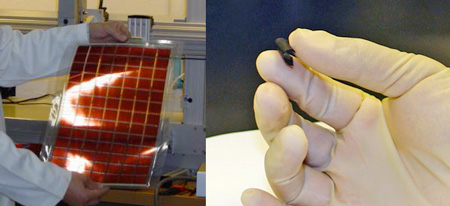Tuesday Topsight, October 9, 2007
 Trying to get back into the blogging groove I found just before my Budapest trip. Here are some of the items of note I've stumbled across recently.
Trying to get back into the blogging groove I found just before my Budapest trip. Here are some of the items of note I've stumbled across recently.
• PowerPaper: This came up in August, but some recent work reminded me about it.
Researchers in Rensselaer Polytechnic Institute announced in the Proceedings of the National Academies of Sciences the invention of a paper battery. Infused with carbon nanotubes, this material is currently able to hold a reversible charge of >>110mAh/g -- a bit better than the typical alkaline battery, a bit worse than the typical lithium-ion battery.
The difference is that this paper battery -- which can also function as a high-discharge super-capacitor -- is extraordinarily flexible, and can be torn, folded or cut without damaging the energy storage properties.
Given that blood and sweat can serve as an electrolyte for the battery, much of the speculation has focused on biomedical applications. But what struck me was that this was a perfect partner for photovoltaic polymers -- "nano-solar" -- as an integrated, flexible power generation and storage system. Imagine buying power by the square meter: the combination of solar plastic and paper battery means that issues around intermittence can be mitigated, and the flexibility means easy installation by non-specialists.
One likely first use: self-powered animated bumper stickers.
The current production methods are time-consuming and fiddly, but another RPI announcement just a few days later might change that: desktop printing of carbon nanotube "ink" onto paper, using an off-the-shelf ink-jet printer.
• Must Wear Silver Jump Suit to Drive: If I could, the first thing I'd stick some of that combo solar paper on would be a new Aptera.
 This is the 3-wheel car that gets over 200mpg as a plug-in hybrid, and looks like it's straight out of a 70s science fiction movie. I first wrote about the Aptera back in early 2006, at WC; as with most of the hypercar designs I ran into, I expected the Aptera to be an exciting proposal that would fade away as the designers got bored or funding dried up. Much to my surprise, the Aptera site is now taking orders for a middle-of-next-year launch. While (as expected) the specs have been reduced some (it was originally supposed to hit over 300mpg, for example), this is still very much the funky hypercar the "Accelerated Composites" folks proposed 18 months ago.
This is the 3-wheel car that gets over 200mpg as a plug-in hybrid, and looks like it's straight out of a 70s science fiction movie. I first wrote about the Aptera back in early 2006, at WC; as with most of the hypercar designs I ran into, I expected the Aptera to be an exciting proposal that would fade away as the designers got bored or funding dried up. Much to my surprise, the Aptera site is now taking orders for a middle-of-next-year launch. While (as expected) the specs have been reduced some (it was originally supposed to hit over 300mpg, for example), this is still very much the funky hypercar the "Accelerated Composites" folks proposed 18 months ago.
Here's the deal: a refundable $500 deposit gets your name on the waiting list for the first production run. There are to be two models: an all-electric, with a decent (100+ mile) range, and a diesel-electric hybrid. Prices are supposed to be in the mid-$20K range. Getting this information is like pulling teeth, however, because Aptera has the worst, least-accessible, most frustrating website I've encountered in a long time: all Flash, launches with music, and does without any kind of summary page.
Still, despite the lack of web design skills, I'm really, really tempted.
• Cracks in the (Bio)Brick House: Rob Carlson notes that the emerging biotechnology of using standardized, modular biological parts to assemble synthetic organisms (or "genetically engineered machines") is already seeing its first intellectual property dust-up. From early on, these standardized, modular biological parts (SMBPs) have been referred to as "biobricks" -- a pretty common-sense term, evoking both the classic image of basic components for building structures and the snap-together, make-what-you-want construction fun of LEGO. It was so common sense that the organization seeking to create and referee standards decided to call itself the BioBricks Foundation (BBF), and to slap a trademark on the term "biobrick." The BBF is now actively admonishing people who use "biobrick" in a generic way to describe SMBPs.
Rob notes the underlying difficulty of this argument, and asks some damn good questions:
Obviously, the idea ofBiobricksBiobrick parts (Argh!) is itself new and interesting, but I wonder what the effect on innovation will be under an apparently new kind of IP regime if one organization is in a position to "defend" not just a standard but also parts that conform to the standard. What happens if the leadership (or control) of the BBF changes and suddenly the "open and free-to-use collection" becomes not so open? And am I free to build/identify a new part as a Biobrick part (!) without submitting it to the Registry or the BBF? Can I even advertise something as being compatible with the standard on my own, or do I have to have permission from the BBF to even suggest in public that I have something other people might want to use/buy that works with all the other Biobrick™ parts? And who exactly controls the Registry?
If transparency is important for standards surrounding relatively staid technologies (such as bolt sizes or network protocols), it's absolutely fundamental for technologies that elicit concerns about health, safety and the environment. If Rob Freaking Carlson can't readily get the answers to these questions, how can everyday citizens do so, let alone get answers to the potentially more troubling concerns about the uses and abuses of the new technology?





